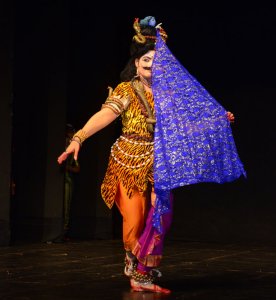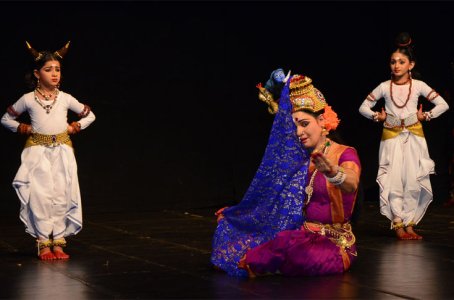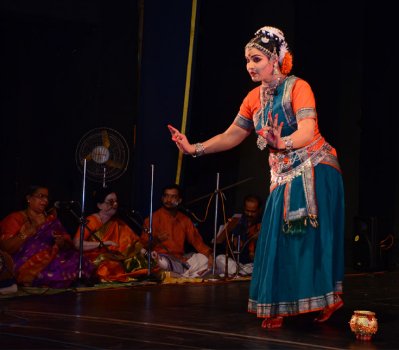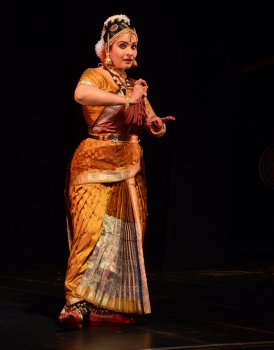
|   |

|   |
Flavors of devadasyam Kuchipudi - Padma Jayaraj e-mail: padmajayaraj@gmail.com Photos courtesy: Dhanya Menon May 16, 2014 Salabhanjika Studio for Arts and Performance based in Thrissur teaches dance in tune with the traditional tenets. For the third consecutive year, it conducted a workshop Devadasyam under the aegis of Dr. C.P. Unnikrishnan and artist Nandan Pillai, to introduce the native strains of Kuchipudi to the students. On the evening of May 4, Dhanya Menon, the star attraction of the institution, presented a unique item with the familiar theme of Ardhanareeswar, a Yakshagaana adaptation from the Pagatti Vesham.   Ardhanareeswar Margam in essence, the performance embodied the male and the female principles in the form of Siva and Parvathi. Two different formats were used in an innovative manner to present the two different aspects. Yakshaganam was used to present the vigorous male dance while Kuchipudi presented the lasya of the female form. Costume, ornaments and make-up delineated the two qualities of the one entity, Ardhanareeswar. People of Thrissur sat glued to their seats watching the one hour performance. The main role donned by Dhanya, the team effort set to recorded music, was impressive as a construct. Originally learned from Ardhanareeswaram Venkat of Andhra, Dhanya’s contribution to the choreography and music has given it a classical touch. The event began with an introduction, Nandi sloka. Both Sanskrit and Telugu were combined to create the text. The myth of Ardhanareeswar was narrated like an argument between lovers and its finale as its harmonious conclusion. Interspersed with characters like Nandi and other dancers who tell the tale in a group performance, the event was showcased as a dance drama. Siva -Parvathi, the ultimate couple in the Indian mythology was its central theme. Siva, the archetypal male sweeping the stage in the format of Yakshagana showed power and strength. We get only the side view as a screen hides the other part. The head that carries Ganga, the poised face with the hint of a smile, the snake that adorns his neck and the tiger-skin that forms his clothes, constituted the persona of Siva. Then as the dancer turns, we see the other side, the hidden profile, the persona of Parvathi, the embodiment of female grace. Her long hair projects her face aglow with lasya bhava, her feminine ornaments, her deep-red saree and her stylized poise. A rare grace pervades the hall. The dance steps changed into Kuchipudi. We almost forget the other aspect. Then the theme set in. Parvathi takes her spouse to task. She, the daughter of Himavan has every right; her hard-won love after great tapasya should be accountable. What does this Ganga gleaming from his matted hair mean? Of course it was to protect the earth, to save living beings of the subcontinent that Siva decided to intervene. The other telltale signs of the blue neck are not the marks of collyrium but the deadly poison that Siva swallowed to save the three worlds…the argument moves on at the phenomenal dimension and Parvathi meekly accepts the heroics of her husband. The grand finale was the revelation of Siva’s consummate love for her. Siva reveals his persona as Ardhanareeswar. The performance set in ragamalika and talamalika concluded with the celebratory recital of ‘Om Nama Sivaya.’ The second day saw two pieces by Dhanya giving the flavor of traditional Kuchipudi that the modern dance form has forgotten during its evolution. The orchestra created the chemistry; costume and choreography its enchantment. Its costume reminding of its folk roots (the milkmaid of Yadava community), and its dialogue reminiscent of Yakshaganam was an eye-opener that revealed the charms of devadasi Kuchipudi. The dialogue between the milkmaid and the Brahmin priest in simple Telugu and Sanskrit was full of wit and sarcasm dealing with caste system of the times. It established the highest philosophy that all are born as sudras and acquire Brahminhood by karma. The orchestra was unique; mridangam by Vijaykumar, violin by Ramesh, nattuvangam and vocal by the sisters Annabattula Lakshmi Mangathayaru and Annabattula Leela Sai from the village of its origin.  Golla kalapam  Jakulapurandari Jakula is a dancer community who lived in a place called Sri Kurmaum in Andhra Pradesh. The dancer calls herself as the beloved of the lord. The performance began with salutations to Sridevi, the embodiment of bhava, raga, tala and rasa. And then the dancer salutes the king. In beautiful traditional Kuchipudi costume the performance moved on to complement the orchestra; mridangam- Vijaykumar, violin-Ramesh, nattuvangam - Rema Vaani Sundari, vocal - Sanathana Shenoy. The story is the churning of the ocean of milk for Amruta. In due course, Siva consumes the poison from Vasuki; kalpaka vriksha, Kamadhenu and Mahalakshmi emerge, and finally amruta. The Devas and the Asuras fight. Mohini, the ultimate enchantress, materializes to hoodwink the Asuras. The Devas get the amruta and dance to immortality. Mohini dissolves into the essence of Vishnu. The dancer completes the story. Pattathil Dhanya Menon, the consummate dancer as Mohini reveals her passion for dance although her profession is cyber crime investigation. The attractive costume of Mohini and the charming bhava abhinaya of the enchantress created the illusion that a Salabhanjika had alighted from one of the temple friezes to dance the legend. According to Dhanya, devadasi Kuchipudi from a village of Andhra is the oldest traditional form. She believes we need to preserve such forms for their aesthetic and traditional aspects. The resource person for the workshop Annabattula Lakshmi Mangathayaru, is a legendary guru of the devadasi style from Mummidivaram village in Andhra and is the last living link in this style. “By Devadaasyam, we only sought to introduce the art pattern and practices which were once followed and practiced by the devadasis of Andhra Pradesh. The Golla Kallapam performed and practiced by Annatbattula Lakshmi Manga Thayuru is the Aalaya Sampradaya. But they also practice the various patterns which they themselves call as devadasi repertoire of Kuchipudi,” says Dhanya. Padma Jayaraj is a freelance writer on the arts and travel. She is a regular contributor to www.narthaki.com |